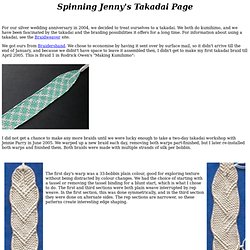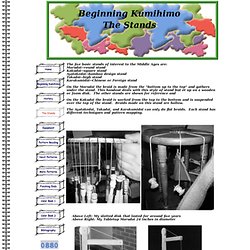

Ayatakedai braids. All things kumihimo. The ayatakedai (eye-ah-taw-kay-dye)(top photo) makes warp twined bands much like tabletwoven bands.

They have a separate double weft that is perpendicular to the warp. Our ayatakedai is made so that the weaver sits in a chair. (It can also be made for kneeling, please contact us.) This ayatakedai holds 10 feathers (hane, Japanese for the pieces of wood protruding from the front) so that bands can be made using up to 60 tama with the two-tiered feathers included and 80 tama with the three-tiered feathers which can be ordered separately. The BraidersHand version of the ayatakedai, bottom photo, (The original takadai/ayatakedai was developed by Aiko Sakai, Makiko Tada's mother.
One hundred gram tama are traditionally used with the ayatakedai, however you might want to start with the tama that you already have on hand. As in all of our products the ayatakedai uses a fastner system that was originally developed for conference booths because they were reassembled so often. Build Your Own Taka Dai. Order a set of measured drawings to build your own taka dai.

This design was created with the modern braider in mind. Sits on the floor to be used while sitting in a standard chair instead of kneelingGreater width between the lower rails reduces fatigue and back strain during long braiding sessions - no more leaning forward or pulling in the elbowsHeld together with mortise and tenon joints - no screws to strip after repeated assembly & disassemblyEasily taken apart for travel to classes and workshops - all pieces fit into the Pelican 1750® rolling travel case (inside dimensions 50.62" x 13.50" x 5") Accommodates up to 22 koma to allow greater flexibility with double-layered braids Seven 11x17" color pages of measured drawings and diagrams. $25.00 includes USPS First Class shipping within the United States.
Contact me for information on shipping charges for international addresses or expedited shipping. Spinning Jenny's Takadai Page. For our silver wedding anniversary in 2004, we decided to treat ourselves to a takadai.

We both do kumihimo, and we have been fascinated by the takadai and the braiding possibilities it offers for a long time. For information about using a takadai, see the Braidweaver site. We got ours from Braidershand. We chose to economise by having it sent over by surface mail, so it didn't arrive till the end of January, and because we didnt't have space to leave it assembled then, I didn't get to make my first takadai braid till April 2005. This is Braid 1 in Rodrick Owen's "Making Kumihimo": I did not get a chance to make any more braids until we were lucky enough to take a two-day takadai workshop with Jennie Parry in June 2005. The first day's warp was a 33-bobbin plain colour, good for exploring texture without being distracted by colour changes. In the next two patterns, the back differs from the front, so I'm showing both.
Kumihimo with a takadai. KumiStands. The five basic stands of interest to the Middle Ages are: Marudai--round stand Kakudai--square stand Ayatakedai--bamboo design stand Takadai--high stand Karakumidai--Chinese or Foreign stand On the Marudai the braid is made from the "bottom up to the top" and gathers under the stand.

On the Kakudai the braid is worked from the top to the bottom and is suspended over the top of the stand. The Ayatakedai, Takadai, and Karakumidai can only do flat braids. I remembered to update my page on 5/26/2013 Beginning Kumihimo The Stands Above Left: My slotted disk that lasted for around five years Above Right: My Tabletop Marudai 24 inches in diameter Right: Takadai fromt the back and from the front Left: Wooden Ayatakedai Right: My Ayatakedai made out of pvc pipe and paint stirring sticks.